Do you like adventure? Adventure makes a person always young, so never stop it. Here is an adventure tour to China, you must not miss it. In the following itinerary, Yunnan adventure tours, Beijing adventure tours, Tibet adventure tours are all included. In this journey, you will stand on the majestic Great Wall and imagine yourself conquering the world like Emperor Qin Shihuang; you will trek through the Tiger Leaping Gorge at a depth of 3,000 meters and feel the magic of nature; you will walk into the highest and most mysterious palace - Potala Palace, and discover the splendor of Tibet a thousand years ago. Of course, some must-see attractions are also included, such as the Forbidden City, Summer Palace, Terracotta Warriors, and so on. Escape from the hustle and bustle of work and let's take this adventure tour to China.

Welcome to Hong Kong. Your wonderful 17-day adventure tour will start here. Your guide will be waiting for you with your name sign in the arrival hall. And then we will drive you to the hotel. Then you can arrange the rest of the day by yourself. If you are tired, you can have a rest in your room; if not, you can stroll around to have fun.
Hong Kong, a special administrative region of China, is located in the southeast of China with a land area of about 1,106 square kilometers. It is the world’s third-largest financial center as well as an important international trade and shipping center. Hong Kong consists of four parts, including Hong Kong Island, the New Territories, Kowloon Peninsula, and the outlying islands. In Hong Kong, most people can speak English, so when you come here, you can talk to them freely to know more about Hong Kong. All kinds of cuisines from all over the world are gathered here, including spicy Thai soup, delicious Indian curry, Korean barbecue, Vietnamese salad rolls, Japanese sushi, etc.
Today, your journey will start. In the morning, you will visit the Wong Tai Sin Temple. Built in 1945, it is one of the most well-known temples in Hong Kong with an area of 18,000 square meters. In addition, the temple is the only Taoist temple in Hong Kong where weddings can be held here. So, if you plan to register for marriage here, you will have the most special wedding. Why is it called Wong Tai Sin Temple? Tai Sin is the Cantonese word for immortal. The temple is named after a person called Wong Chuping, who has achieved enlightenment and become immortal. It is said that he has done many good deeds, such as healing illnesses, rescuing the dying, etc. So people built a temple for him. Besides, the temple’s fortune-telling is very famous and popular. Many people come to visit the temple each year to divine their future and pray for good fortune. If you want to have your fortune told, you should kneel in front of the main altar, make a wish, and shake a bamboo cylinder where fortune sticks are contained until one stick falls out. And then the master here will tell you about your fortune according to the words on the stick.
After that, you will enjoy a pleasant time in Victoria Peak. With an altitude of 554 meters, Victoria Peak is the highest point in Hong Kong, which is located northwest of Hong Kong Island. It has always been a symbol of Hong Kong as well as one of the most popular attractions here. How to get to the top of the peak? There is no doubt that the Peak Tram is your best choice. As the earliest tram in Asia, it has been in use for more than 100 years without accidents. It only takes seven minutes to reach the top of the peak by taking the tram. The opening and ending scenes of the famous movie “Soldier of Fortune”, in which the Oscar winner Clark Gable plays the leading role, were both shots in the tram. After reaching the peak, you will see the Peak Tower, which is designed by the famous British architect Terry Farrel. Its appearance is like a huge bowl. The tower is a must-see spot that integrates sightseeing, entertainment, and shopping. Here is the best site to overlook entire Hong Kong.
In the afternoon, you will visit the Stanley Market. The market is one of the most popular markets for tourists because of its various souvenirs, such as traditional Chinese clothes, silk, ornaments, etc. It is the perfect place to buy gifts and souvenirs for your friends and relatives. What’s most important is that when you buy things there, you can bargain. Moreover, there are many western-style bars. If you are tired, you can have a drink here.
After the visit, we will transfer you to your hotel. The rest of the day is your free time.
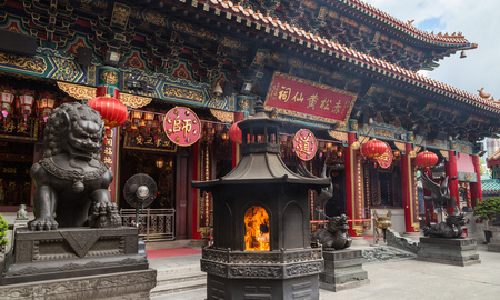
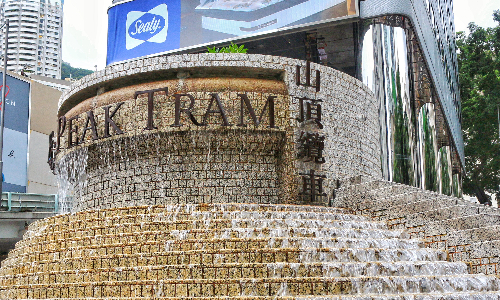
Today, after breakfast, we will drive for about 40 minutes (35 KM) to Lantau Island. Located on the west side of Hong Kong Island, Lantau Island is the largest island in Hong Kong covering an area of 147 square kilometers. On this Island, there is an incredible journey you must experience — the Ngong Ping Cable Car journey. The cable car connects the center of Tung Chung and Ngong Ping with a length of 5.7 kilometers. It adopts a safe and reliable cable car system with double-cable, which is the first of its kind in Hong Kong. You will take the Standard Cabin. The cabin can accommodate up to 17 people, including 10 seats as well as a space reserved for wheelchair users. The whole journey takes about 20 minutes. During the interesting ride, you will enjoy pleasant sceneries. You can overlook the North Lantau Country Park, the South China Sea, Hong Kong International Airport, and Tung Chung Valley. After getting off the cable car, you will have more sightseeing.
After finishing the ride, you will go to Ngong Ping Village which is close to the Ngong Ping Cable Car Terminal. It covers an area of 13,400 square meters, with a total floor area of 5,000 square meters. The buildings in the villages are highly endowed with Chinese characteristics. There are various dining, retail, and entertainment establishments in the village. In addition, there are several attractions in it. Po Lin Monastery is one of them. As for the location, it is between Phoenix Mountain and Maitreya Mountain. It was originally built by three masters, Dunxiu, Dayue, and Yueming from the Jinshan Temple in Zhenjiang County, Jiangsu Province. Initially, it was called Da Maopeng, and it was not until 1924 that the first generation of abbot Jixiu officially named it Po Lin Monastery. The monastery comprises a variety of halls, including the Ti-tsang Bodhisattva Hall, the Great Buddha Hall, the Maitreya Hall, the Sutra-Collection Hall, the Banruo Hall, and other spectacular structures.
Then we will visit the Big Buddha. Built in the early 1990s, it is located on the top of Muyu Mountain on Lantau Island. It is welded from 202 pieces of bronze and weighs 250 tons. Covering an area of 6,567 square meters, the Buddha is the world’s largest bronze statue with a height of 34 meters (its pedestal is included). Since its pedestal follows the design of the Temple of Heaven (called Tian Tan in Chinese) in Beijing, it is often called “Tian Tan Big Buddha”. The appearance of the Buddha is referenced to the Lushana Buddha in the Longmen Grottoes, while the clothing pattern and headdress are referenced to the Sakyamuni Buddha statue in the Mogao Grottoes. Therefore, the Buddha has the characteristics of sculptures in the Sui and Tang Dynasties (581 - 907). After ending the visit, you will take the cable car down the mountain. And then, your guide will take you back to the hotel. If there is spare time, you can arrange it freely.

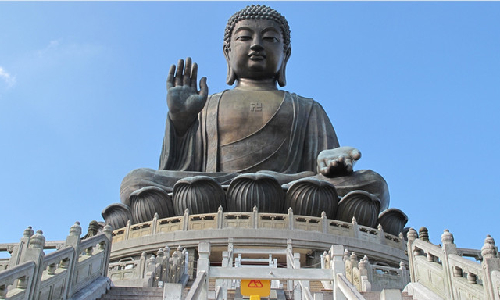
 Kunming
Kunming In the morning, your guide will transfer you to the airport and you will take a flight to your next city — Kunming. Your new guide, holding your name sign, will wait for you at the airport.
Welcome to the “Spring City” Kunming. Before going to the hotel, you will first pay a visit to the Flowers and Birds Market. Located at Jingxing Street, the market is one of the most attractive shopping markets in Kunming. It was opened in 1983 and has now developed into a dream place for shopping and sightseeing, which is a must for both Kunming citizens and tourists from other places. From the market’s name, you can know that birds and flowers play important roles in the market. Besides, it is also a popular trade place for antiques, like jade articles, jewelry, curios, ink stones, potteries, etc. Here, you can bargain with shopkeepers to buy something at a good price. After that, you will be transferred to the hotel and you can have a good rest to prepare for the next day’s visit.
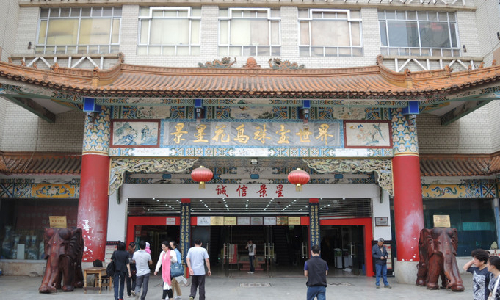

 Lijiang
Lijiang After enjoying your breakfast, we will drive east for about 70 minutes (78 KM) to visit the famous Stone Forest Located in Shilin Yi Autonomous County in Kunming, the forest is at an altitude between 1,500 meters and 1,900 meters. Stone Forest is the world’s only karst landscape area located in the subtropical plateau area. About 300 million years ago, this place was a wilderness of water. After a long period of geological evolution, extremely precious geological relics were finally formed, covering many types of karst landforms. It is composed of 7 attractions, including Major and Minor Stone Forest, Naigu Stone Forest, Dadie Waterfall, Long Lake, Zhiyun Cave, Moon Lake, and Qifeng Cave. Enjoy the magic of nature here!
After lunch, we will take the estimated train D8789 17:00/20:42 to Lijiang. Located on the southeastern edge of the Qinghai-Tibet Plateau, Lijiang was an important passage for the ancient “Southern Silk Road” and the “Old Tea Horse Road”. While the geographical location of the city is remote, it enjoys a pleasant and temperate year-round climate as well as a variety of tourist resources in the area of 20,600 square kilometers.
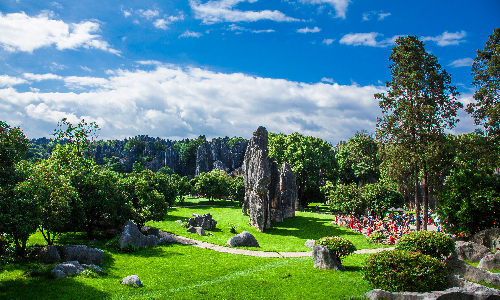
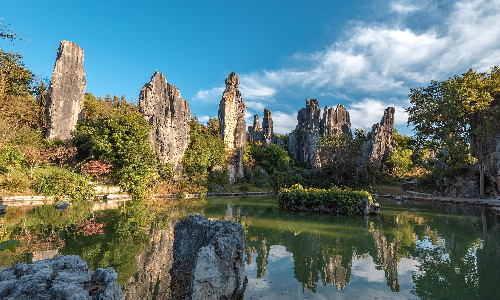
Today, you will first go to see the Jade Dragon Snow Mountain, which is located in the north of Lijiang City. We will drive for about 40 minutes (22 KM) to get there. The mountain is the second highest mountain in Yunnan Province. After getting there, we will take a cable car to visit Spruce Meadow. Also known as the “land of love” and “Splendid Vale”, the Spruce Meadow is a huge lawn hidden behind a primeval spruce forest. The meadow witnesses different sceneries each season. In spring and summer, the meadow is full of lush green grass and beautiful flowers. In autumn, the whole color of it changes to orange. And in winter, the meadow is wrapped with white snow, which can glut your eyes. It is said that it is the place where the first couple of lovers of the Naxi people died in love. This is why it is known as the “land of love”.
Then, you will take a cable car down the mountain to visit the Blue Moon Valley. The valley is named after the blue water of the lakes and the crescent shape of the valley. Another anecdote says that because the valley is similar to the Blue Moon Valley in the “Lost Horizon” written by British writer James Hilton, it is named “Blue Moon Valley”. The river in the Blue Moon Valley is blocked by the mountains, so four lakes are formed, namely Blue Moon Lake, Jade-Like Wine Lake, Mirror Pond, and Wave-Listening Lake. The four lakes form a giant natural mirror reflecting the spectacular snow mountain and lush plants. When it rains, the white mud at the bottom of the lake will be swirled up, turning the water into white. Therefore, the local Naxi people also call it the White Water River (Baishui River).
After having lunch at a local restaurant, we will drive southwest for about 15 minutes (12 KM) to visit Baisha Mural Paintings in Baisha Village where a large number of native Naxi people live. On account of the opening up of the Naxi nationality in the Ming Dynasty (1368 - 1644), the drawing of the mural paintings has lasted for more than 300 years. The paintings combine the culture of Naxi, Han, and Tibetan nationalities, showing the life scenes of people at that time. And Baisha Mural Paintings is one of the world’s intangible cultural heritages.
After that, we will drive south for about 15 minutes (10 KM) to visit Dongba Culture Museum. Built in 1984, the museum was originally named Lijiang County Museum and officially renamed Dongba Culture Museum in July 1999. The museum now houses more than 12,000 cultural relics, including more than 2,500 Dongba cultural relics. It is the museum with the largest collection of Dongba cultural relics in the world. Dongba culture is the traditional Naxi culture with a history of thousands of years. It is inextricably linked to the local Dongba religion, including national beliefs, folk rituals, Dongba ancient documents written in Naxi hieroglyphics, as well as the papermaking and printing technology mastered by Dongba priests. In the Dongba Culture Museum, you will admire the distinctive culture thousands of years ago.
At last, you will visit Lijiang Ancient Town. With an area of 7.3 square kilometers, the town is located in the Old Town of Lijiang, also known as Dayan Town. It was built at the end of the Song Dynasty (960 - 1279) and the beginning of the Yuan Dynasty (1271 - 1368). There are Square Street, Mu Family Mansion, Baisha Residential Buildings, Shuhe Residential Buildings, and other attractions in the town. Lijiang Ancient Town is the only old city built without a city wall. It is said that Lijiang was ruled by the Mu family for several hundred years, and the family was given the surname “Mu” by the emperor of the Ming Dynasty. If the Chinese character, mu, is surrounded by four straight lines, it will become another Chinese character, Kun, which means trapped. The Mu family believes that if walls were built around the city, their family will be like this Chinese character, being trapped. To avoid taboos, the ancient town has never been given a city wall.
Tips:
1. Spruce Meadow is 3,240 meters above sea level, so altitude sickness may occur when traveling here. If you have had altitude sickness before, you can take medicine with you.
2. Please keep away from cattle and sheep in the scenic area to avoid accidental injury.

 Shangri-La
Shangri-La After breakfast, we will drive west for about 1 hour and 10 minutes (55 KM) to the First Bend of the Yangtze River. Located between Shigu Town and Shasongbi Village, the first bend is 1,850 meters above sea level. Yangtze River rushes down from the “Roof of the World”, the Qinghai-Tibet Plateau, and enters Yunnan Province from Batang County. It travels through the high mountains and deep valleys of the Hengduan Mountains together with the Lancang River and the Nu River, forming a magnificent landscape of “Three Parallel Rivers”. When it arrives at Shasongbi Village, it suddenly makes a sharp turn of more than 100 degrees and turns to the northeast, forming a rare V-shaped bend. This is what we are going to visit today, the First Bend of the Yangtze River.
Then, we will drive northeast for about 60 minutes (50 KM) to Tiger Leaping Gorge, which is one of the deepest gorges in China. With a vertical height difference of more than 3,900 meters, it faces the Jade Dragon Snow Mountain to the east and Haba Snow Mountain to the west. Located in the upper reaches of the Jinsha River, it is 17 kilometers in length with three sections: the upper section, the middle section, and the lower section, wherein the upper section is the narrowest; and the lower section is the best place to appreciate the scenery of the gorge. According to legend, a tiger leaps across from one side of the gorge to the other by using the rock here as its stepping stone, so it is named Tiger Leaping Gorge.
At noon, we will have lunch at a local restaurant. And then we will drive northwest for about 1 hour and 40 minutes (100 KM) to Shangri-La. Shangri-la means “the sun and the moon in the heart” in Tibetan, and people think this place is an ideal home that can only be found in heaven. Since its first appearance in the novel “Lost Horizon” written by the British writer James Hilton in the 1930s, it has been longed for by the world. There are magnificent snowy mountains, steep and grand gorges, azure lakes, endless grasslands, and bucolic villages, which always leave a strong and deep impression on visitors.

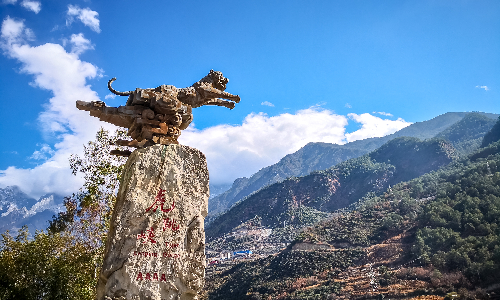
This morning, you will go to visit the Songzanlin Monastery today, which is the largest Tibetan Buddhist monastery in Yunnan Province. It was built between 1679 and 1681. Located on the foot of Foping Mountain, the monastery looks like a complex of ancient castles and consists of two lamaseries, Zhacang and Jikang. It boasts a large collection of Tibetan plastic arts, so it is also known as the “Tibetan Art Museum”. There are many treasures in it, such as eight golden Buddha statues of Sakyamuni, Tibetan lections, golden lamps, and silver censers, etc. Moreover, since the monastery is similar to the Potala Palace in its appearance, it is also called “Little Potala Palace”. Here is the best place to admire Tibetan culture in Yunnan.
In the afternoon, you will pay a visit to Potatso National Park. It needs to drive east for about 50 minutes to get there. About 22 kilometers away from the Songzanlin Monastery, it covers a total area of about 1,313 square kilometers and the altitude of the park is between 3,500 meters and 4,159 meters. It is well known for its well-preserved primitive landscape, such as lakes, wetlands, forests, meadows, valleys, streams, rare animals, etc. Potatso National Park can be divided into three main scenic areas, including Shudu Lake in the north, Bita Lake in the south, and Militang Alpine Pasture in the middle, of which the two freshwater lakes are known as “the Pearl of the Plateau”. In addition, there are many rare animals in the park, including the first-class national protected animals - black-necked cranes as well as the second-class protected animals - macaque, lynx, leopards, tufted deer, golden cats, etc.
At last, you will be sent back to your hotel.


 Lhasa
Lhasa Tsetang
Tsetang In the morning, your guide will pick you up at your hotel and transfer you to the airport. Then, you will take an estimated fight MU5774 11:30/13:35 to Tibet, which is one of the five ethnic minority autonomous regions in China. With an average altitude of more than 4,000 meters, it is known as the “Roof of the World”.
Upon arrival, your nice local guide will wait for you at the airport. After driving east for about 1 hour and 30 minutes (105 KM), you will arrive at Tsetang. You will be transferred to your hotel to have a good rest.
Welcome to Tsedang, which is the political, economic, and cultural center of Shannan City. It is the center of the Yalong River Scenic Spot, the only national-level scenic spot in Tibet. First, we will visit Yumbulakang Palace, the first palace in Tibet. As for its name, “Yumbu” means “doe” in Tibetan, from the mountain where it resembles a doe, and “lakang” means “shrine” in Tibetan. According to historical records, it was built in the second century BC. It is said that Yumbulakang is not a monastery at first, but the palace of the leader of the early Yalong tribe. During the period of the reign of Songtsen Gampo (629 - 650), the first king of Tibet, the palace was converted into a monastery. When Princess Wencheng of the Tang Dynasty (618 - 907) came to Tibet to marry Songtsen Gampo, she would like to live here with her husband every summer.
Next, you will go to see Trundruk Monastery. It is one of the first Buddhist monasteries built during the reign of Songtsen Gampo, which belongs to the Gelug Sect (the main sect of Tibetan Buddhism) monasteries. It is said that Princess Wencheng once practiced Buddhism in it. The monastery is composed of three parts: the main hall, the corridor and the courtyard. Tsoqin Hall is served as the main building, in which a statue of Buddha Padmasambhava made of copper is enshrined. The most precious treasure in the monastery is Pearl Thang-ga, which was made in the 14th century. It is a kind of Tibetan painting, studded with pearls and colored gemstones. You will see more Tibetan relics and get a deep understand of Tibetan culture after visiting here.
After enjoying pleasant lunch, we will drive northwest for about 1 hour (45 KM) to Samye Monastery. Built in the 8th century, it was the first formal monastery in Tibet, that allows people to be initiated into monkhood. With an area of 25,000 square meters, the whole monastery faces south and is elliptical. It replicates the universe described in the Buddhist scriptures. The three-story Wuzi Hall with a special design is the center of the whole monastery. Each layer follows different styles: the bottom is Tibetan style; the middle is of Han’s style; the top is of Indian style. Therefore, the monastery is also called the “Three-styled Monastery”.
After the whole day tour, we will transfer you to your hotel in Tsetang (towards the southeast) to have a good rest and the trip will take about 1 hour (38 km).
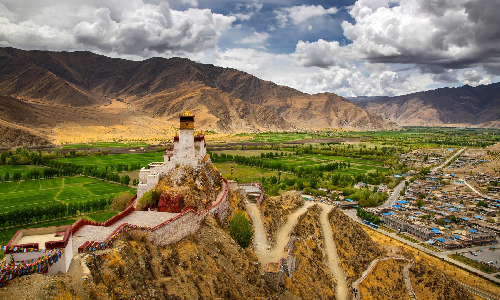
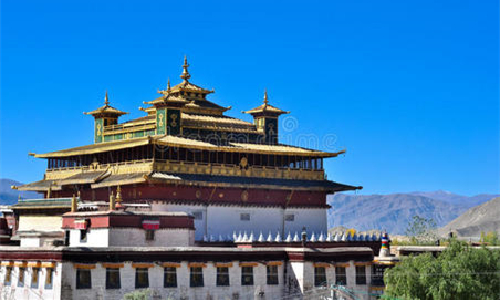
 Yamdrok Lake
Yamdrok Lake Lhasa
Lhasa After breakfast at your hotel, we will leave Tsedang and drive west for about 2 hours and 40 minutes (160 KM) to Yamdrok Lake. The name “Yamdrok Lake” means “Jade Lake” in Tibetan, implying its attractive appearance for pure water, just like exquisite jade. Lying under the bright sunshine, the peaceful and clean water seems like a bright mirror. As one of the three holy lakes in Tibet, it also has another vivid name — Coral Lake. It is named after its irregular shape, as it looks like corals. It is said that devout Buddhists will walk around Yamdrok Lake once a year, each time it takes one month. In this way, they believe the Buddha will bless them every year.
Next, we will drive northeast for about 2 hours 40 minutes (110 KM) to Lhasa, nicknamed Sunshine City. Lhasa means the Holy Land in Tibetan. As the capital city of Tibet Autonomous Region, it is featured by beautiful plateau lakes, tranquil grassland sceneries and grand snow mountains, etc. We will transfer you to your hotel, and you can have a good rest to prepare for the next day’s tour.
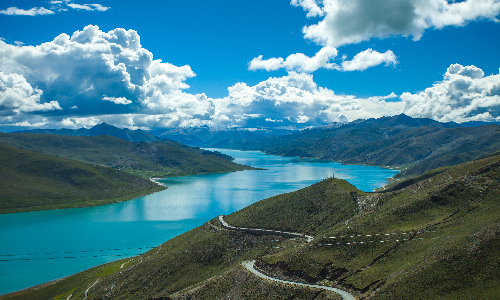
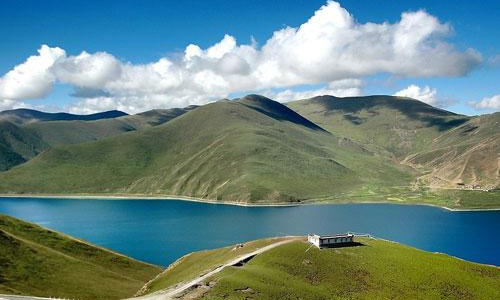
Your trip to Lhasa will start from the Potala Palace. Located on Mabuli Mountain, it is the prototype of the landscape pattern printed on the back of the fifth set of 50 Yuan banknotes. It is a Palace-style building group with the highest altitude in the world, integrating palaces, castles and monasteries, and it’s also the largest and most complete ancient palace and castle in Tibet. The palace is originally used for greeting a princess of the Tang Dynasty, Wencheng Princess. Legend has it that to greet his beautiful bride princess, the Tibet King Songtsen Gampo built a 9-story palace and named it Potala. The palace consists of two parts, the Red Palace and the White Palace, wherein the former is the home to Lingta Halls (where the remains of the Dalai Lamas are stored) and the latter is served as offices of Dalai Lamas.
After lunch, we will take you to visit the Jokhang Temple first. With a history of 1300 years, it was built by Songtsan Gampo with an area of more than 25,100 square meters. It is one of the most brilliant buildings in Tibet which combines the architectural styles of Tibet, central China, Nepal, and India. Most monasteries in Tibet belong to a certain sect of Tibetan Buddhism, while the Jokhang Temple is a sacred temple respected by all sects and has a supreme position in Tibetan Buddhism.
Then, you will visit Barkhor Street. Situated in the old town of Lhasa City, it is a well-known circumambulation of pilgrimage and commercial center of Lhasa. It completely preserves the traditional appearance of ancient Lhasa City and the lifestyle here. It is composed of East Barkhor Street, West Barkhor Street, South Barkhor Street, and North Barkhor Street. Today, you may see many pilgrims walking clockwise here with prayer wheels held in their hands. Besides, various shops and stores stand on both sides, offering prayer wheels, Tibetan knives, and other religious articles as well as Tibetan specialties, which you can buy as souvenirs for your friends and family.

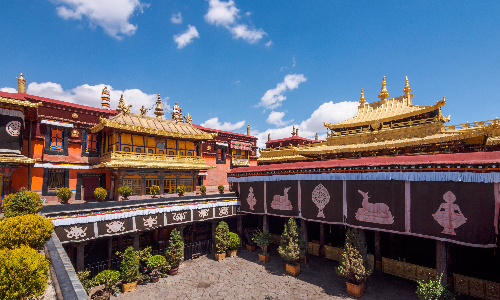
After breakfast, we will visit Norbulingka Park first. Located in the western suburb of Lhasa, the park was built in the 1840s. Norbulingka means “Treasure” in Tibetan. Covering an area of 360,000 square meters, it is the garden with the largest scale, the best scenery and the most historical sites among the man-made gardens in Tibet. It is used as the summer palace for successive Dalai Lamas to deal with political affairs and hold festival celebrations.
Next, you will visit the Drepung Monastery, which was built in 1416. The monastery was built in Ming Dynasty by Jiangyang Qujie, the disciple of the Gelug Patriarch Tsong Khapa, with the financial support of a local great aristocrat. Situated at the southern slope of the Mountain Gamboutse, the Drepung Monastery is known as the largest monastery in Lhasa and even in Tibet. Covering an area of about 250,000 square meters, it is called the “Three Great Monasteries” in Lhasa together with the Ganden Monastery and the Sera Monastery. Since the monastery looks like a heap of rice, it is named “Drepung”, which means “Collecting Rice” in Tibetan.
After lunch, we will have our last stop today is the Sera Monastery. It was built by Tsong Khapa’s disciple- Jamchen Chojey and finished in 1434. Since the hill behind it was filled with wild roses when it was built, it is named “Sera”, which means “wild roses” in Tibetan. Covering an area of 114,946 square meters, the monastery is magnificent and grand. Its main buildings consist of Coqen Hall, Kamcun Hall and Zhacang Hall. There are tens of thousands of Vajra Buddha statues preserved here, most of which are made locally in Tibet, and some are brought from central China or India. Furthermore, diversified debates on Buddhist doctrines are held here, which distinguishes it from Lhasa’s other famous monasteries. Lamas participate in these debates to improve their comprehension of Buddhist scriptures.


 Beijing
Beijing This morning, we will transfer you to the airport. And you will take the estimated fight TV9815 10:00/13:35 to the next city — Beijing, the capital of China. Upon arrival, your Beijing guide will transfer you to the hotel, and you will have a free afternoon.
Beijing has over 3,000 years of history as a city and over 850 years of history as a capital. It is a city with the most world cultural heritages in the world, as well as a historical and cultural city and one of the eight ancient capitals of China. Here, you will have a new and different experience!
Option: As one of the commercial symbols of Beijing, Wangfujing Street is the most famous and prosperous shopping street with fashion and modern trends. Here, you can see a variety of boutiques and big shops, some of which are world-famous brands. And there are many traditional Chinese time-honored stores, such as Tongshenghe Shoe Store, Ruifuxiang Silk & Cotton Shop, Shengxifu Hat Store, etc.
Your wonderful Beijing tour will start from Beijing’s landmark - Tian’anmen Square. In 1949, the Chinese Five-Starred Red Flag was raised here the first time. It has witnessed the founding of the People’s Republic of China. Here, you can see the Tian’anmen Gate Tower, the Great Hall of the People, the Monument to the People’s Heroes, and Chairman Mao Zedong Memorial Hall. Nowadays, thousands of people come to the square every day.
Walking through the square, you will reach your next stop — the Forbidden City (closed on Mondays). Located in the center of Beijing’s central axis, the Forbidden City is the imperial palace in the Ming(1368-1644) and Qing (1636-1912)Dynasties. The buildings in the Forbidden City in Beijing consist of two parts: the Outer Court and the Inner Court. The center of the Outer Court is the Hall of Supreme Harmony, the Hall of Central Harmony, and the Hall of Preserving Harmony, collectively referred to as the Three Great Halls, where the emperors held major ceremonies. The center of the Inner Court is the Palace of Heavenly Purity, the Hall of Union, and the Palace of Earthly Tranquility, collectively referred to as the Back Three Palaces, which are the main palaces where the emperors and their families lived.
After lunch, you will visit the Summer Palace, a royal garden of the Qing Dynasty. Covering an area of about 3 square kilometers, it is the largest classical garden in China. It is mainly composed of Longevity Mountain and Kunming Lake. In addition, it owns more than 3,000 man-made ancient structures, including corridors, pavilions, bridges, towers, etc. When you come here, the Long Corridor, Marble Boat, and Grand Theater at Garden of Virtue and Harmony are what you cannot miss.
Your last destination today is Qianmen Street. Located at the central axis of Beijing, Qianmen Street is a very famous and popular commercial street in Beijing with a length of 845 meters and a width of 20 meters. It was originally called Zhengyangmen Street from the Ming and Qing Dynasties to the Republic of China. And it was officially named Qianmen Street in 1965. On the street, there are various foods, including one of Beijing’s most famous restaurants – Qianmen Quanjude Roast Duck Restaurant, which is the first restaurant of the Quanjude brand. Quanjude makes the most authentic Peking Roast Duck, so if you would like to taste this famous dish by yourself, you can come here.


After breakfast, we will drive southwest for about 1 hour and 10 minutes (45 KM) to the Mutianyu Great Wall, which is located in Huairou District, Beijing. With a total length of 5,400 meters, the wall is currently the longest and best-known section of the Great Wall in China. And it is equipped with first-class two-way cable cars. You can take a chairlift to go up and down, or you can choose to get on a chairlift to get up and take a toboggan to get down. Besides, there are many foreign leaders who have visited the Mutianyu Great Wall, including former British Prime Minister John Roy Major, former U.S. President William Jefferson Clinton and former U.S. President Barack Obama.
After having lunch near the Mutianyu Great Wall, we will drive for about 2 hours (70 KM) back to downtown Beijing. On the way, we will stop at the Water Cube and the Bird’s Nest to take photos from outside. They are both located in the Beijing Olympic Park and built for the 2008 Summer Olympics.
In the afternoon, you will enjoy a pleasant time in Beijing Hutong. Hutong refers to narrow alleys, lanes, or small streets between rows of single-story Siheyuan (quadrangle courtyard). It is often said that the native culture of Beijing can be fully embodied in Hutong and Siheyuan. The old lifestyle of ordinary Beijingers is fully showed here. It was formed in the Yuan Dynasty (1271-1368) and has a history of more than 700 years. Furthermore, when you come here, you can take the rickshaw to visit Hutong. And then we will drive back to the hotel.

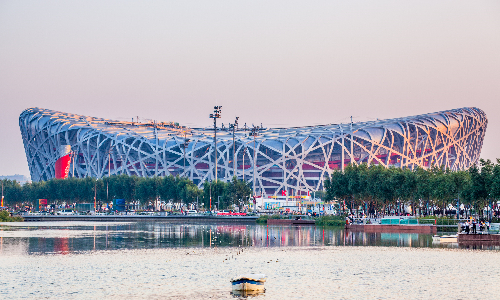
Today, your 17-day tour is over and you will say goodbye to China. We will transfer you to the airport. We hope you have a nice journey and look forward to serving you next time!
Editor: Wang Chen
Proofreader: Summer Hou
| City | Five Star hotel list | Four Star hotel list |
|---|---|---|
| Hong Kong | Harbour Grand Kowloon | Harbour Plaza North Point Hotel |
| Kunming | Grand Park Kunming | UChoice Hotel |
| Lijiang | Wonderport International Hotel | Lijiang Wangfu Hotel |
| Shangri-La | Paradise Hotel | Ri Yue Xing Cheng Hotel |
| Tsetang | Guest House | Guest House |
| Lhasa | Shangri-La Hotel Lhasa | Thangka hotel |
| Beijing | Sunworld Dynasty Hotel Beijing Wangfujing | Sunworld Hotel Wangfujing |
 |
![]() About your child or infant, please contact us for a discounted price.
About your child or infant, please contact us for a discounted price.



We started with a few days in Beijing & ended in Shanghai, from where we visited the Forbidden City and Great Wall. In between we visited Terra Cotta Warriors Museum, Panda Base, Shanghai Disneyland.

We had a wonderful holiday in China which will remain long in the memory. China is a breathtakingly beautiful country full of splendid temples and palaces, mountains and rivers, peaceful rural scenes and bustling shopping streets.
 QUICK ENQUIRY
QUICK ENQUIRY